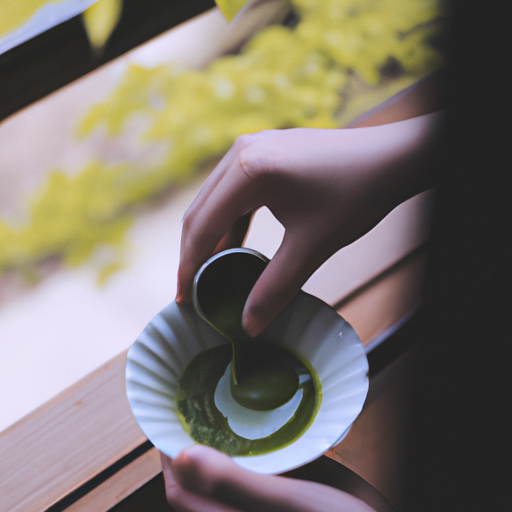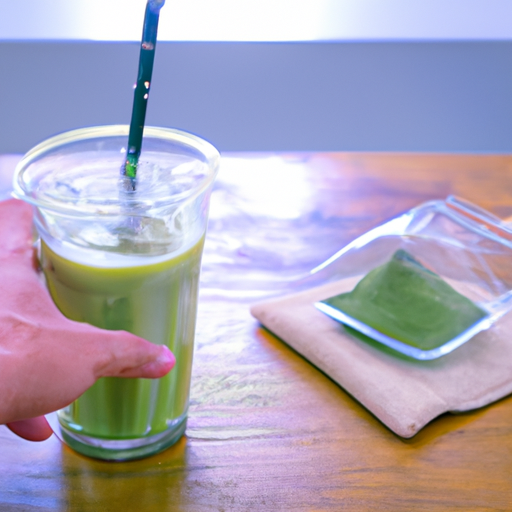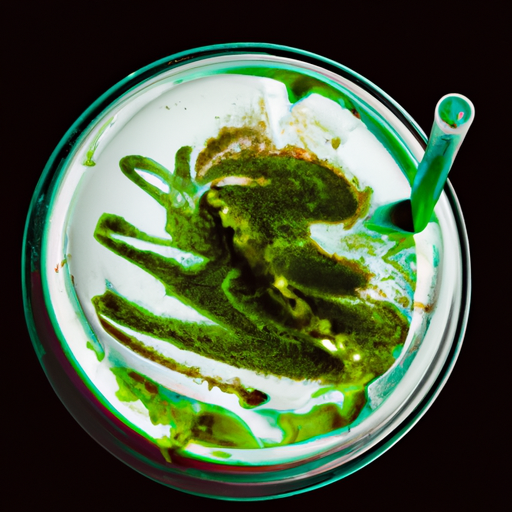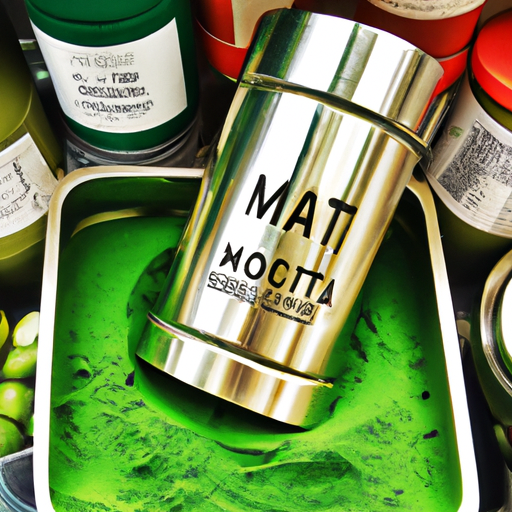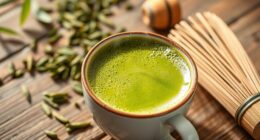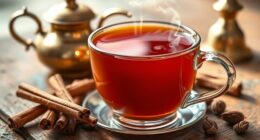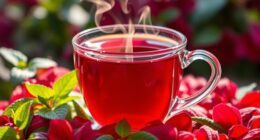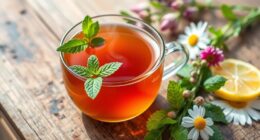Have you ever caught yourself looking at the term ‘matcha’ on a menu or a product and pondered its correct pronunciation? Speaking as an enthusiast of this brightly colored green tea for a lengthy period, I’ve encountered this query on numerous occasions. Although it might appear trivial, being able to pronounce matcha accurately can significantly change your experience when placing an order at a coffee shop or talking about your preferred beverage with pals.
So, let’s clear things up once and for all: matcha is pronounced ‘MA-cha.’ The first syllable is emphasized and the ‘t’ sound is not fully pronounced, which makes sense given that matcha comes from Japan and follows Japanese pronunciation rules.
Now that we’ve got that out of the way, let’s dive into why this tea is so beloved by millions around the world.
Key Takeaways
- Matcha is a type of green tea that originated in China and was brought to Japan by Buddhist monks, where it became an integral part of Japanese culture, especially ceremonial practices.
- Matcha is high in catechins, an antioxidant that protects against free radicals, and contains caffeine, which can increase metabolic rate aiding in weight loss. It also contains L-theanine, which promotes relaxation and reduces stress. The combination of caffeine and L-theanine improves cognitive function.
- Matcha is finely ground into a powder and mixed with hot water, and its higher levels of antioxidants than regular tea are due to consuming the entire powdered leaf.
- Matcha is graded based on the quality of tea leaves used, and the ideal temperature range for brewing is 160°F-175°F (70°C-80°C). It is important to use a bamboo whisk for even consistency when preparing matcha.
The Origins of Matcha
Did you know that matcha originated in China and was brought to Japan by Buddhist monks? The history of matcha dates back to the Tang Dynasty in China, where it was used for medicinal purposes. Later on, during the Song Dynasty, matcha became part of Chinese tea ceremonies.
However, it wasn’t until Zen Buddhism arrived in Japan that matcha truly took off. Japanese Zen monks were fascinated with the ritualistic aspect of drinking tea and incorporated it into their daily lives. They even developed a new form of tea ceremony called chanoyu, which emphasized simplicity and mindfulness.
Today, matcha is still an integral part of Japanese culture, especially when it comes to ceremonial practices such as the traditional tea ceremony. But beyond its cultural significance lies a plethora of health benefits that make this green powder a popular choice among health enthusiasts.
The Health Benefits of Matcha
Matcha’s health benefits are numerous and well-known, making it a popular choice among health enthusiasts. Here are five of the most significant benefits:
-
High in antioxidants: Matcha contains high levels of catechins, a type of antioxidant that helps protect your body against damage from free radicals.
-
Boosts metabolism: The caffeine in matcha can help increase your metabolic rate, which may aid in weight loss.
-
Calming properties: Matcha also contains an amino acid called L-theanine, which has been shown to promote relaxation and reduce stress.
-
Improves brain function: The combination of caffeine and L-theanine can improve cognitive function, including memory and attention span.
-
Versatile ingredient: Matcha can be used in a variety of recipes, from drinks like lattes and smoothies to desserts like cakes and cookies.
With all these benefits, it’s no wonder that matcha has become such a popular ingredient for those looking to improve their overall health. Whether you’re looking for a natural energy boost or trying to add more antioxidants into your diet, matcha is definitely worth considering.
In the next section, we’ll discuss the difference between matcha and other teas. While they may seem similar on the surface, there are some key differences that set matcha apart.
The Difference Between Matcha and Other Teas
When exploring the world of teas, you may be curious about the differences between matcha and other varieties. Matcha is a type of green tea that is finely ground into a powder and mixed with hot water to create a frothy, vibrant drink. Regular tea, on the other hand, typically involves steeping whole or loose leaves in hot water before consuming. Herbal tea is made by infusing herbs or spices in hot water, often without any actual tea leaves.
| Matcha | Regular Tea | Herbal Tea |
|---|---|---|
| Made from powdered green tea leaves | Made from whole or loose tea leaves | Made from herbs or spices |
| Contains more caffeine than regular tea | Caffeine content varies depending on type and steep time | Typically caffeine-free |
| Provides antioxidants and nutrients like chlorophyll and L-Theanine | Provides antioxidants but may not have as high levels of nutrients as matcha | May provide additional benefits depending on specific herbs used |
While all types of teas offer some level of health benefits, matcha stands out for its unique preparation method and nutritional profile. Compared to regular tea, matcha has higher levels of antioxidants like catechins and polyphenols due to consuming the entire powdered leaf rather than just steeping the leaves. Additionally, matcha contains more caffeine than regular tea but also contains L-Theanine which can promote feelings of relaxation without drowsiness.
In comparison to herbal teas, matcha offers a different set of benefits due to its use of green tea leaves versus various herbs or spices. While herbal teas can provide specific health benefits based on the ingredients used (such as chamomile for calming effects), they may not contain the same concentration of nutrients found in matcha. Ultimately, whether choosing matcha over regular or herbal teas depends on personal preference and desired health outcomes.
As we’ve discussed the differences between various types of teas including their nutritional profiles, it’s important to note the proper pronunciation of matcha.
The Correct Pronunciation of Matcha
As someone who loves drinking matcha, I often hear people mispronouncing it. The correct way to say it is “maht-cha,” with emphasis on the first syllable.
Common mispronunciations in English include “muh-chuh” and “match-uh”.
In this subtopic, we’ll discuss the importance of pronouncing matcha correctly and how to do so.
The proper way to say “maht-cha”
You might think it’s difficult to pronounce matcha, but don’t worry – it’s actually quite easy once you know that it’s pronounced ‘maht-cha’.
Matcha is a powdered green tea that has gained popularity in recent years due to its health benefits and unique flavor. The word ‘matcha’ comes from the Japanese words ‘ma’ (meaning ground or rubbed) and ‘cha’ (meaning tea), which refers to the way the tea leaves are ground into a fine powder.
Understanding the proper pronunciation of matcha can also help with understanding its cultural significance. Matcha has been an important part of traditional Japanese tea ceremonies for centuries. These ceremonies involve carefully preparing and serving matcha in a ritualistic manner.
In addition to being a source of caffeine, matcha is also believed to promote relaxation and mindfulness during these ceremonies.
With all this in mind, next we’ll explore some common mispronunciations in English.
Common mispronunciations in English
Don’t let your pronunciation trip you up – there are some common mispronunciations of matcha in English that you should be aware of. While the proper way to say matcha is "maht-cha,"many people make errors due to regional variations or simply not knowing the correct pronunciation. Here are some common mispronunciations and how they differ from the correct way:
| Mispronunciation | Correct Pronunciation |
|---|---|
| Mat-cha | Maht-cha |
| Mah-chee | Maht-cha |
| Match-a | Maht-cha |
| Mate-tcha | Maht-cha |
It’s important to note that these variations may come from different regions where the emphasis or accent might be different. However, it’s always a good idea to stick with the correct pronunciation when ordering or discussing matcha.
Moving on to tips for making the perfect cup of matcha, it’s important to understand how much powder to use and how long to whisk it for optimal taste and texture.
Tips for Making the Perfect Cup of Matcha
Perfectly preparing a pot of matcha requires patience, precision, and practice. It’s not just about boiling water and whisking the green powder. One of the key factors to consider is the grade of matcha you’re using.
Matcha grades are determined by the quality of tea leaves used to make them. Higher grades use only the youngest and most tender leaves from the top of the tea plant, resulting in a richer flavor profile and smoother texture.
Another important factor in making a perfect cup of matcha is water temperature. The ideal temperature range for brewing matcha is between 160°F-175°F (70°C-80°C). Boiling water can burn and damage your precious tea leaves, while cooler temperatures may not properly extract all the flavors from your matcha powder.
Lastly, remember that whisking technique matters too! Use a bamboo whisk to create an even consistency throughout your drink. You’ll want to move quickly but gently when whisking so as not to overdo it or leave any clumps behind. Once you’ve achieved a frothy layer on top, you’re ready to sip on your perfectly prepared cup of matcha!
Matcha has become increasingly popular in modern culture due to its health benefits and versatility in culinary creations like lattes, smoothies, and desserts. But before we dive into how it’s being used today, it’s important to first understand how this ancient Japanese tea tradition has evolved over time.
Matcha in Modern Culture
Matcha has become a trendy ingredient in various culinary creations, including lattes, smoothies, and desserts. In recent years, matcha cafes have popped up all over the world as people embrace this Japanese green tea powder not only for its health benefits but also for its unique taste.
Matcha-inspired desserts are also gaining popularity, with many pastry chefs incorporating it into their creations. If you walk into a matcha cafe today, you will likely find an assortment of drinks and dishes that incorporate matcha. Here are some examples:
- Matcha latte: A popular drink made by mixing matcha powder with hot water or milk.
- Matcha ice cream: A creamy dessert that combines the bitterness of matcha with the sweetness of ice cream.
- Matcha mochi: A traditional Japanese dessert made from glutinous rice flour and filled with sweet red bean paste or fruit.
- Matcha cheesecake: A rich and decadent cake that uses matcha to give it a distinct flavor and color.
As more people discover the versatility of matcha in cooking and baking, we can expect to see even more creative uses of this ingredient in the future.
With its growing popularity comes concerns about sustainability in match production. While there’s no doubt that demand for this tea has increased significantly in recent years, it’s important to ensure that production remains sustainable in order to protect both the environment and the livelihoods of those who grow it.
The Sustainability of Matcha Production
As matcha continues to gain popularity, it’s important to consider the sustainability of its production. Can we ensure that this high demand can be met without harming the environment or those who grow it? Sustainable farming practices are crucial for matcha production since it’s grown in shaded areas, which require a lot of resources such as water and fertilizers. Additionally, some farmers use heavy machinery that can damage the soil and nearby wildlife.
To address these concerns, many matcha producers have started implementing sustainable farming methods. For example, some farms use natural fertilizers like compost instead of chemical ones. Others have started using solar-powered machines to reduce their carbon footprint. These efforts not only help preserve the environment but also support local communities by providing them with safer working conditions and fair wages.
However, there is still more work to be done in terms of reducing the environmental impact of matcha production. As consumers, we can do our part by supporting companies that prioritize sustainability and by being mindful of our own consumption habits. By making small changes in our daily lives, we can help ensure that future generations will continue to enjoy this delicious and healthful beverage while protecting the planet at the same time.
Moving on from sustainable farming practices, let’s explore different variations of matcha and how they differ from one another.
Variations of Matcha
You may be surprised to learn that there are various types of matcha, each with its own unique flavor and texture. Matcha grades are determined by the quality of the tea leaves used, as well as how they are processed.
The highest grade is ceremonial matcha, which is made from the youngest and most tender leaves. It has a delicate sweetness and smooth texture that makes it perfect for traditional Japanese tea ceremonies.
On the other end of the spectrum is culinary matcha, which is made using older leaves that have a stronger flavor profile. This type of matcha is often used in recipes for baking or cooking, as it can hold up to other strong flavors without being overpowered.
Finally, there is premium matcha, which falls somewhere in between ceremonial and culinary grades. It has a slightly more robust flavor than ceremonial matcha but still maintains its smooth texture.
Understanding these different types of matcha can help you choose the right one for your needs – whether you’re looking to enjoy a traditional tea ceremony or add some extra depth to your favorite recipe. In the next section, I’ll share some tips on how to incorporate this delicious ingredient into your diet in creative ways.
Transitioning into incorporating matcha into your diet: Whether you prefer sipping on a hot cup of tea or adding it to your morning smoothie bowl, there are plenty of ways to enjoy all that matcha has to offer. Let’s explore some fun and creative ways to incorporate this flavorful ingredient into our daily routines!
Incorporating Matcha into Your Diet
Indulging in the vibrant green goodness of matcha can take your culinary creations to a whole new level, adding a unique flavor and nutritional boost to your dishes.
One easy way to incorporate matcha into your diet is by making a delicious matcha smoothie. Simply blend together almond milk, banana, spinach, and a teaspoon of matcha powder for a refreshing and energizing drink.
But why stop at just smoothies? Matcha can also be used in dessert recipes for an added twist on traditional treats. Try making matcha ice cream or incorporating it into brownies or cookies for a flavorful and healthy twist on classic desserts.
Not only does adding matcha to your diet provide delicious flavor options, but it also offers numerous health benefits such as antioxidants, fiber, and vitamins.
So next time you’re looking for an easy way to amp up your meals or snacks, consider incorporating the vibrant green goodness of matcha into your culinary creations!
Frequently Asked Questions
Does matcha contain caffeine?
When it comes to the question of whether matcha contains caffeine, the answer is a resounding yes. In fact, matcha has about three times as much caffeine as a typical cup of steeped green tea.
But there’s more to matcha than just its energizing effects. Matcha benefits include a wealth of antioxidants and other nutrients that can help support overall health and wellness.
And while some might think that all matcha is created equal, there are actually different varieties available depending on how the leaves are grown and processed. So whether you’re looking for a pick-me-up or simply want to explore the world of tea, there’s plenty to discover when it comes to matcha.
How long does matcha stay fresh?
When it comes to storing matcha, it’s important to keep in mind its shelf life. Matcha can go bad if it’s not kept properly, so you’ll want to make sure you’re storing it correctly.
Generally speaking, matcha should be stored in an airtight container that’s kept away from heat and moisture. This will help ensure that the tea stays fresh for as long as possible.
The shelf life of matcha can vary depending on a number of factors including how it was processed and packaged, but most high-quality matcha should last around six months to a year when stored properly.
To extend the shelf life of your matcha even further, consider keeping it in the fridge or freezer, which can help preserve its flavor and freshness even longer.
Can matcha be used in cooking and baking?
Matcha is a versatile ingredient that can be used in a variety of recipes, from sweet to savory. Its subtle and slightly bitter flavor makes it a great addition to baked goods like cakes, cookies, and muffins.
It can also be used in savory dishes like soups, sauces, and marinades. Not only does matcha add unique flavor to your cooking and baking, but it also provides numerous health benefits.
Matcha is packed with antioxidants called catechins which are known for their anti-inflammatory properties. Incorporating matcha into your food not only adds flavor but also boosts the nutritional value of your meals.
There are countless matcha recipes available online that you can try out for yourself and enjoy the many benefits of this superfood in your diet.
What is the difference between ceremonial grade and culinary grade matcha?
I’m a huge matcha fan and, to be honest, I can’t imagine my life without it. One thing that often confuses people is the difference between ceremonial grade and culinary grade matcha.
Both are made from high-quality green tea leaves, but they differ in terms of flavor, texture, and color. Ceremonial grade matcha is considered the highest quality because it’s made from the youngest leaves on the tea plant, which are shade-grown and hand-picked. This results in a bright green powder with a smooth texture, delicate flavor profile, and sweet aroma.
On the other hand, culinary grade matcha is made from older leaves that are sun-grown and machine-harvested. It has a slightly bitter taste and darker color compared to ceremonial grade matcha. While both grades can be used in cooking or baking, ceremonial grade matcha is best reserved for traditional Japanese tea ceremonies or for sipping as a standalone beverage due to its superior quality.
When it comes to Matcha Quality Comparison between these two grades – always go for Ceremonial!
Is matcha safe for children to consume?
As a nutritionist, I’m often asked about the safety of consuming matcha for children. While matcha does offer many potential benefits, it’s important to consider the risks and dosage recommendations before giving it to kids.
Matcha contains caffeine, which can have negative effects on children’s sleep patterns and mood. It also has high levels of antioxidants that can be beneficial for their overall health.
The recommended dose for children is no more than 1-2 ounces per day, as excessive consumption may lead to adverse effects such as stomach upset or nausea.
As always, it’s best to consult with a healthcare professional before introducing any new food or drink into your child’s diet.
Conclusion
Well, there you have it, folks – the correct pronunciation of matcha! I hope this article hasn’t only clarified that for you but also provided insight into the origins, health benefits, and sustainability of this beloved tea.
As I sip on my perfectly whisked cup of matcha, I can’t help but imagine myself in a serene Japanese garden surrounded by cherry blossom trees, with the sound of water trickling from a nearby pond.
Matcha truly transports me to another world with its rich flavor and vibrant green color. Incorporating matcha into your diet isn’t only beneficial for your health but can also add a touch of elegance to your daily routine.
So, go ahead and indulge in some matcha goodness today!

